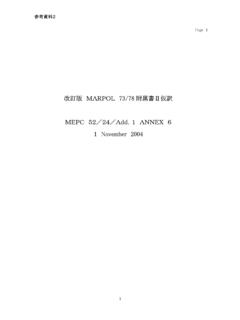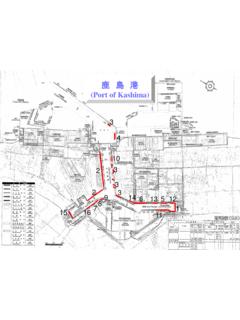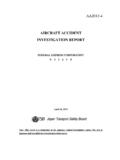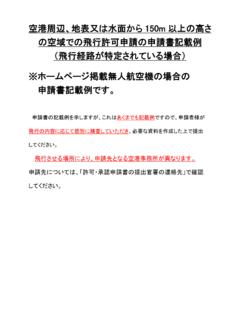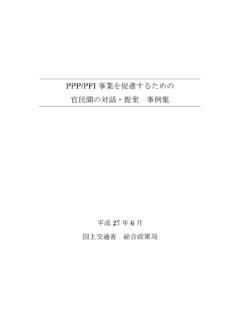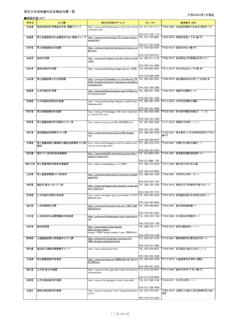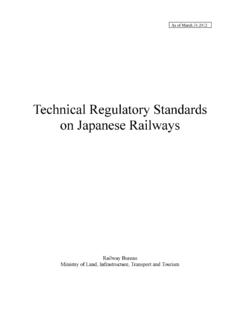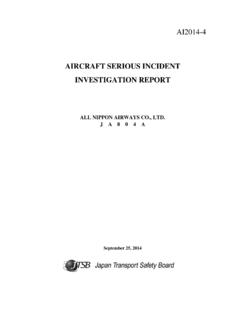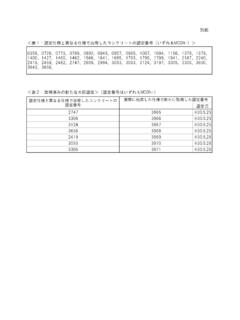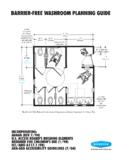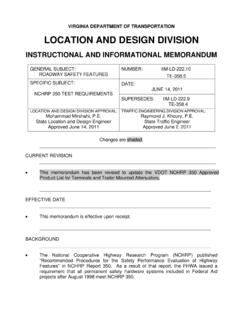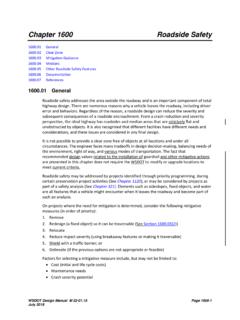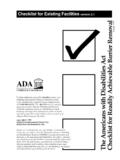Transcription of General Principles of Universal Design Policy
1 General Principles of Universal Design Policy July 2005. Ministry of Land, Infrastructure and Transport General Principles of Universal Design Policy Table of Contents Introduction .. 1. I. Present state and challenges .. 3. 1 Past efforts 2 Challenges to be overcome to achieve Universal Design II. Basic concept of the General Principles of Universal Design 7. 1 Constructing a participation society from the perspective of users 2 Integrating barrier free policies 3 Public transportation that all people can use safely and smoothly 4 Creating communities where everyone can live safely and comfortably 5 Providing for diverse activities based on technology, methods, etc. III. Specific 12. 1 Construction of systems for the participation of diverse concerned people based on the concept of Universal Design 2 Creation of systems for assessments and information sharing based on the concept of Universal Design ( Universal Design assessments). 3 Promotion of integrated and comprehensive barrier free measures 4 Enacting standards and guidelines based on the concept of Universal Design 5 Completing non-physical measures (realization of a psychologically barrier free society 6 Realization of public transportation that all people can use safely and smoothly 7 Planning communities where everyone can live safely and comfortably 8 Flexible response to various people and activities 9 Application of IT and other new technologies 10 Comprehensive spread of pioneering efforts (leading projects and leading areas).)
2 General Principles of Universal Design Policy Introduction Japan has, as a consequence of a process of modernization and industrialization that has taken place mainly in the twentieth century, become one of the world's major economic powers. During the half century since the end of World War II, it has experienced particularly rapid urbanization and industrialization and created urban and transportation systems appropriate to its new status. These were adapted to a society whose principal characteristic was growth. But now at the beginning of the twenty-first century, Japanese society has entered a period of radical change. The simultaneous aging of the population and decline of the birth rate are bringing an unprecedented period of population decline. This society is introducing measures to support independent activities planned so that elderly people can autonomously select their own life styles. Efforts are also being made to create a gender equal participation society that lets both men and women mutually exercise their distinctive characteristics and capabilities.
3 It is also essential to create a symbiotic society in which handicapped people make independent choices and decisions to enter and participate fully in all social activities. Therefore, measures to help all handicapped people exercise their own capabilities to achieve self-actualization are being introduced. Continued internationalization is deepening links between Japanese society and foreigners who come here to do business, tour Japan, and for other purposes. We are entering an age when we must make efforts to create a society in which every person can exercise his or her own unique qualities in this way and participate freely in society to achieve self-actualization. The Ministry of Land, Infrastructure and Transport (MLIT) is now implementing national land and transportation policies based on the concept of Universal Design *1 that is defined as the Design of facilities, easily and freely used anywhere, by anyone in order to create such a society by providing social capital and transportation systems that will support society in the twenty-first century.
4 In October of last year, the MLIT established the Universal Design Policy Promotion Headquarters within the ministry. It has now conducted discussions a total of fifteen times. It prepared these General Principles by carrying out an overall examination of all fields of national land and transportation administration and conducting discussions with experts both inside and outside of Japan, and at the same time, has linked discussion groups formed to deal with the way to achieve barrier free *2 conditions, to smooth the use of public transportation systems and to promote Free Mobility Project *3. Through this organization's activities, the Ministry of Land, Infrastructure and Transport will reform the consciousness of every one of its employees so that the entire organization will implement national land and *1. Universal Design : This is the concept of designing cities and living environments that can be utilized without difficulty by everyone including the handicapped, people of all ages and of both genders, and of all races (From the Basic Plan for Handicapped People (Cabinet Decision of December 24, 2002)).
5 *2. Barrier free: This is the process of removing barriers preventing elderly and handicapped people for example from participating in the life of society. It is the concept of moving all obstacles including physical, social, systemic, psychological, and information obstacles. (From the Basic Plan for Handicapped People (Cabinet Decision of December 24, 2002)). *3. Free Mobility Project: This refers to projects that apply revolutionary ubiquitous network technologies to use Ubiquitous Location Information Systems that provide necessary information anytime, anywhere, to anyone in real time in order to provide system users with information such as travel routes, transportation methods, and destinations by voice, by a letter, and in multiple languages to allow the elderly and handicapped to travel freely to destinations they wish to reach. 1 . transportation policies based on the concept of Universal Design , and it is counting on internal groups and individuals who play a variety of roles working together to undertake aggressive measures to achieve the above goals.
6 2 . I. Present state and challenges 1. Past efforts In the past, cities and transportation systems were provided in Japan assuming that they would be used mainly by people free of any handicaps. The realization that Japan will soon become an aged society and the growing demand by handicapped people to participate fully in society has been accompanied by the beginning of efforts to remove barriers to the use by elderly and handicapped people of buildings, roads, public transportation systems and other spaces. { In 1982, building Design standards that consider the use of buildings by handicapped people were enacted. { In 1983, guidelines to the provision of facilities for the use of handicapped people in public transportation terminals were enacted. { In 1991, It was stipulated that in principle, newly constructed public rental housing must be barrier-free. Example of barrier-free measures in homes Installation of handrails Widening corridors Removal of level differences { In 1993, The Road Structure Regulations were revised to permit wheelchair users to meet and pass each other safely and smoothly.}}}}
7 Example of a sidewalk on Example of a sidewalk near a hospital etc. a road with few pedestrians 3 . { The Act on Buildings Accessible and Usable by the Elderly and Physically Handicapped (Heartful Building Law) was enacted in 1994. Image of a Heartful Building Entrances/exits Wheelchair users can easily pass What is a Heartful Building through building entrances/exits and doors Parking lot Bath etc. Parking lot spaces are planned so that they The bathroom and shower can be used easily by wheelchair users. room can be used easily even by wheelchair users. Toilet The toilet can be used easily even by wheelchair users. Corridor etc. Wheelchair users and visually handicapped people can confidently and easily move Elevator through corridors. Wheelchair users and Guide blocks for visually visually handicapped Stairway Approach handicapped people people can use elevators Stairways have gently It is sloped and free of level slopes and are equipped differences to the entrance. Visually handicapped people walk easily.}
8 With handrails. safely on guide blocks. { In 2000, The Law for Promoting Easily Accessible Public Transportation Infrastructure for the Aged and the Disabled (below called the Transportation Barrier-Free Law ) was enacted. Example of Transportation Barrier Free Measures Installation of elevators Non-step busses *4. Improvement of level differences and slopes on sidewalks and the installation of guide blocks for visually handicapped people *4. Non-step bus: It is a bus designed so that wheelchair users can board without assistance: busses with their floors less than 30cm from the ground, no level differences at exits/entrances, wheelchair spaces, and aisles wide enough for the passage of wheelchairs. 4 . And social capital provision and transportation policies are implemented systematically to achieve preset goals. Barrier Free Measures: Present State and Goals Barrier free rate Goals of social capital Facility Barrier free measures Present time provision priority plans (2003).}
9 (2007). Elimination of level differences 44% Above 70%. Passenger facility (1) Guide blocks for visually handicapped 74% Above 80%. people Removing level differences, ensuring 25% About 50%. Road (2) width, installing guide blocks for visually handicapped people Building (3) Providing handrails and wide corridors 30% About 40%. Housing Providing handrails and wide corridors About 3% About 10%. Notes: (1) Passenger facility used by an average of at least 5,000 people/day (examples: railway stations, bus terminals, etc.). (2) Major roads surrounding (1). (3) Stipulated buildings used by an unspecified large number of people (examples: hospitals, theaters, hotels, etc.). Percentage of cars etc. in public transportation systems that are barrier free Target of the Basic Guideline to Present (2003). Smooth Travel (2010). Railway cars 24% 30%. Non-step busses 9% 20 25%. Passenger ships 4% 50%. Airplanes 32% 40%. Changing Number of Acceptances of a Basic Concept in Accordance with the Transportation Barrier-Free Law Number of Acceptances Number of Acceptances (Cumulative).
10 (Changes by quarter) FY2004. 40 Total of 62 basic concepts 200. FY2003. 35 Total of 65 basic concepts 175. 189. 29 179. 170. 30 28 150. 127 156. 25 117 125. FY2002. Total of 47 basic concepts 20 90 100. 104. FY2001 15. Total of 15 basic concepts 14 14. 15 13 13 75. 11 11 10 10. 9. 10 8 62 50. 28 47. 5 15 25. 2 36. 1 4 1. 0 0. ril Ju ly er 2 ril . ly . er 3 ril . Ju ly er 4 ril . ly . er . 05.. Ap tob 2 00 Ap Ju tob 2 00 Ap tob 2 00 Ap Ju tob 20. Oc ua ry Oc ua ry Oc ua ry Oc ary Ja n Ja n Ja n nu Ja Note) Includes basic concepts prepared by cities, towns, or villages without a passenger facility used by an average of at least 5,000. people/day (total of 10 basic concepts). Quarterly Cumulative 5 . 2. Challenges to be overcome to achieve Universal Design In order to construct a society in which all people can exercise their individuality and their capabilities and participate fully in that society to achieve self-actualization, it is important to adopt the perspectives of fairness, that means not discriminating between users, freedom of choice (flexibility) that permits flexible satisfaction of individual needs, and participation that encourages planning with the participation of users and residents, based on the concept of Universal Design : designing facilities that are easily and freely used anywhere, by anyone.
